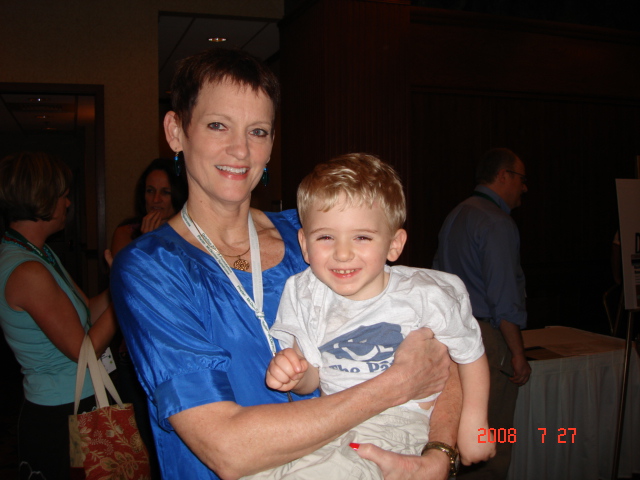|
SAM PICTURED WITH DR. KATY PHELAN
Phelan-McDermid Syndrome, otherwise known as 22q13 is a rare genetic anomaly
caused by the absence of genes at the tip of the long-arm of the 22
nd chromosome. Phelan–McDermid is one of the rarest and under diagnoses developmental syndromes in children
today. Phelan-McDermid Syndrome — is caused by the absence / loss of genes at the tip of the 22nd chromosome,
with lack of the Shank3 / ProSAP2 gene suspected as the primary cause of the symptoms
associated with the syndrome. This gene plays a pivotal role in development of
the human nervous system, including the brain, and loss of this genetic component
prevents proper nervous system construction during fetal development.
There is a wide range of severity of symptoms observed in people with the deletion,
but most exhibit moderate to severe developmental delays, physically and intellectually,
but especially in speaking and communicating. Very low muscle tone is a common
trait of the syndrome, and many have problems with eating, sleeping and emotional
stability.
Most children with this syndrome will have a number of characteristic features, of which Sam has all:
In additon, Sam has secondary diagnosis of: Developmental Delay, Grade 4 Renal reflux, GERD, Low Muscle Tone, Torticollis (shortening of Neck muscle), Phagiocephaly (flatten of one side of head), Aspiration Pneumonia, Pneumonia, Respiratory comprised, Bi-lateral repair due to fluid built up in testicals, Tough tied and upper frenum repair, Chronic Ear infections, Very High tolerance to pain, and Swallowing delays – now on Thicken liquids and puree /mechanical soft diet
It is important to note that the majority of individuals examined with the deletion
are young children so answers about long term abilities and issues are difficult
to predict.

SAM'S BILLBOARD ON WOODRUFF ROAD |

MORE INFO......
http://7thspace. com/headlines/ 282416/deletion_ 22q133_syndrome. html
Author: Mary C. Phelan
Credits/Source: Orphanet Journal of Rare Diseases 2008, 3:14
Published on: 2008-05-27
Author: Mary C. Phelan
Credits/Source: Orphanet Journal of Rare Diseases 2008, 3:14
Published on: 2008-05-27
The deletion 22q13.3 syndrome (deletion 22q13 syndrome or Phelan-
McDermid syndrome) is a chromosome microdeletion syndrome
characterized by neonatal hypotonia, global developmental delay,
normal to accelerated growth, absent to severely delayed speech, and
minor dysmorphic features. The deletion occurs with equal frequency
in males and females and has been reported in mosaic and non-mosaic
forms.
McDermid syndrome) is a chromosome microdeletion syndrome
characterized by neonatal hypotonia, global developmental delay,
normal to accelerated growth, absent to severely delayed speech, and
minor dysmorphic features. The deletion occurs with equal frequency
in males and females and has been reported in mosaic and non-mosaic
forms.
Due to lack of clinical recognition and often insufficient laboratory
testing, the syndrome is under-diagnosed and its true incidence
remains unknown. Common physical traits include long eye lashes,
large or unusual ears, relatively large hands, dysplastic toenails,
full brow, dolicocephaly, full cheeks, bulbous nose, and pointed chin.
Behavior is autistic-like with decreased perception of pain and
habitual chewing or mouthing. The loss of 22q13.3 can result from
simple deletion, translocation, ring chromosome formation and less
common structural changes affecting the long arm of chromosome 22,
specifically the region containing the SHANK3 gene.
The diagnosis of deletion 22q13 syndrome should be considered in all
cases of hypotonia of unknown etiology and in individuals with absent
speech.Although the deletion can sometimes be detected by high
resolution chromosome analysis, fluorescence in situ hybridization
(FISH) or array comparative genomic hybridization (CGH) is
recommended for confirmation. Differential diagnosis includes
syndromes associated with hypotonia, developmental delay, speech
delay and/or autistic-like affect (Prader-Willi, Angelman, Williams,
Smith-Magenis, Fragile X, Sotos, FG, trichorhinophalange al and
velocardiofacial syndromes, autism spectrum disorders, cerebral
palsy).
Genetic counseling is recommended and parental laboratory studies
should be considered to identify cryptic rearrangements and detect
parental mosaicism. Prenatal diagnosis should be offered for future
pregnancies in those families with inherited rearrangements.
Individuals with deletion 22q13 should have routine examinations by
the primary care physician as well as genetic evaluations with
referral to specialists if neurological, gastrointestinal, renal, or
other systemic problems are suspected. Affected individuals benefit
from early intervention programs, intense occupational and
communication therapies, adaptive exercise and sport programs, and
other therapies to strengthen their muscles and increase their
communication skills.
No apparent life-threatening organic abnormalities accompany the
diagnosis of deletion 22q13.